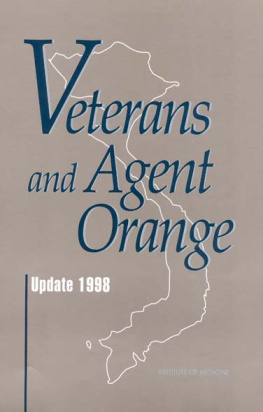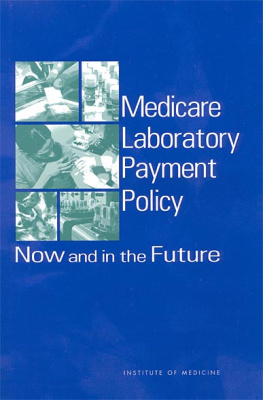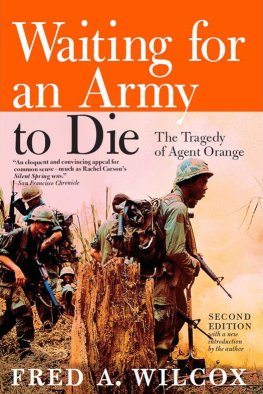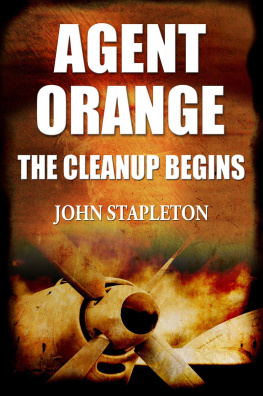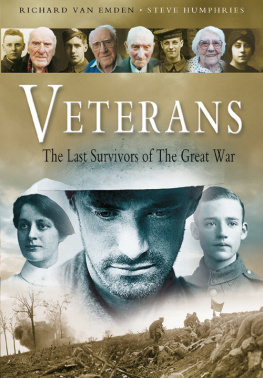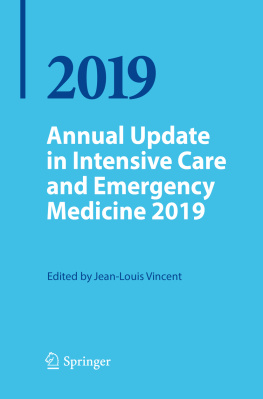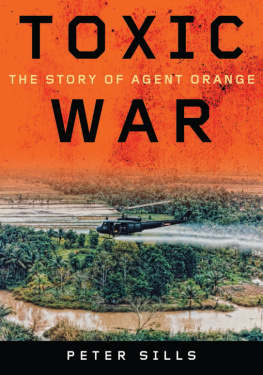Institute of Medicine - Veterans and Agent Orange: Update 1998
Here you can read online Institute of Medicine - Veterans and Agent Orange: Update 1998 full text of the book (entire story) in english for free. Download pdf and epub, get meaning, cover and reviews about this ebook. year: 1999, publisher: NATIONAL ACADEMY PRESS, genre: Romance novel. Description of the work, (preface) as well as reviews are available. Best literature library LitArk.com created for fans of good reading and offers a wide selection of genres:
Romance novel
Science fiction
Adventure
Detective
Science
History
Home and family
Prose
Art
Politics
Computer
Non-fiction
Religion
Business
Children
Humor
Choose a favorite category and find really read worthwhile books. Enjoy immersion in the world of imagination, feel the emotions of the characters or learn something new for yourself, make an fascinating discovery.
- Book:Veterans and Agent Orange: Update 1998
- Author:
- Publisher:NATIONAL ACADEMY PRESS
- Genre:
- Year:1999
- Rating:5 / 5
- Favourites:Add to favourites
- Your mark:
- 100
- 1
- 2
- 3
- 4
- 5
Veterans and Agent Orange: Update 1998: summary, description and annotation
We offer to read an annotation, description, summary or preface (depends on what the author of the book "Veterans and Agent Orange: Update 1998" wrote himself). If you haven't found the necessary information about the book — write in the comments, we will try to find it.
Veterans and Agent Orange: Update 1998 — read online for free the complete book (whole text) full work
Below is the text of the book, divided by pages. System saving the place of the last page read, allows you to conveniently read the book "Veterans and Agent Orange: Update 1998" online for free, without having to search again every time where you left off. Put a bookmark, and you can go to the page where you finished reading at any time.
Font size:
Interval:
Bookmark:
Veterans and Agent Orange
Update 1998
Committee to Review the Health Effects in Vietnam Veterans of Exposure to Herbicides
Division of Health Promotion and Disease Prevention
Institute of Medicine
NATIONAL ACADEMY PRESS
Washington, D.C.
NATIONAL ACADEMY PRESS
2101 Constitution Avenue, NW
Washington, D.C.20418
NOTICE: The project that is the subject of this report was approved by the Governing Board of the National Research Council, whose members are drawn from the councils of the National Academy of Sciences, the National Academy of Engineering, and the Institute of Medicine. The members of the committee responsible for the report were chosen for their special competences and with regard for appropriate balance.
The Institute of Medicine was chartered in 1970 by the National Academy of Sciences to enlist distinguished members of the appropriate professions in the examination of policy matters pertaining to the health of the public. In this, the Institute acts under the Academys 1863 congressional charter responsibility to be an adviser to the federal government and its own initiative in identifying issues of medical care, research, and education. Dr. Kenneth I. Shine is president of the Institute of Medicine.
Support for this study was provided by the Department of Veterans Affairs (contract no. V101(93)P-1331).
ISBN 0-309-17328-0 e-pub ISBN
International Standard Book Number 0-309-06326-4
The serpent has been a symbol of long life, healing, and knowledge among almost all cultures and religions since the beginning of recorded history. The image adopted as a logotype by the Institute of Medicine is based on a relief carving from ancient Greece, now held by the Staatliche Musseen in Berlin.
David Tollerud, MD, MPH (Chair), Professor,
School of Public Health, MCP Hahnemann University
1 Member of the committee responsible for Veterans and Agent Orange (1994).
2 Member of the committee responsible for Veterans and Agent Orange: Update 1996.
Michael Aminoff, MD, Professor,
Department of Neurology, University of California at San Francisco School of Medicine
Steven Goodman, MD, MHS, PhD, Associate Professor,
Department of Oncology, Division of Biostatistics, Johns Hopkins University School of Medicine
Robert Herrick, PhD, CIH, Lecturer on Industrial Hygiene,
Department of Environmental Health, Harvard School of Public Health
Irva Hertz-Picciotto, PhD, Associate Professor,
Department of Epidemiology, University of North Carolina, Chapel Hill
David Hoel, PhD, Distinguished University Professor,
Medical University of South Carolina
Andrew Olshan, PhD, Associate Professor,
Department of Epidemiology, University of North Carolina, Chapel Hill
Trevor Orchard, MBBCh, MMSc, Professor,
University of Pittsburgh, Rangos Research Center
Howard Ozer, MD, PhD, Professor,
Department of Medicine, MCP Hahnemann University
Kenneth Ramos, PhD, Professor,
Department of Physiology and Pharmacology, Texas A&M University College of Veterinary Medicine
Noel Rose, MD, PhD, Professor,
Department of Molecular Microbiology and Immunology, Johns Hopkins University School of Hygiene and Public Health
Susan Woskie, PhD, CIH, Associate Professor,
Department of Work Environment, University of Massachusetts, Lowell
Project Staff
DAVID A. BUTLER, Study Director
SANJAY S. BALIGA, Research Associate
JAMES A. BOWERS, Research/Project Assistant
KATHLEEN R. STRATTON, Director,
Division of Health Promotion and Disease Prevention
DONNA D. DUNCAN, Division Assistant
SHARON GALLOWAY, Financial Associate
Staff Consultants
JANE DURCH, Senior Program Officer,
Institute of Medicine
CAROL MACZKA, Director of Toxicology and Risk Assessment,
National Research Council
FLORENCE POILLON, Contract Editor
In response to the concerns voiced by Vietnam veterans and their families, Congress called upon the National Academy of Sciences (NAS) to review the scientific evidence on the possible health effects of exposure to Agent Orange and other herbicides (Public Law 102-4, enacted on February 6, 1991). The creation of the first NAS Institute of Medicine (IOM) committee, in 1992, underscored the critical importance of approaching these questions from a non-partisan scientific standpoint. The original Committee to Review the Health Effects in Vietnam Veterans of Exposure to Herbicides realized from the beginning that it could not conduct a credible scientific review without a full understanding of the experiences and perspectives of veterans. Thus, to supplement its standard scientific process, the committee opened several of its meetings to the public in order to allow veterans and other interested individuals to voice their concerns and opinions, to provide personal information about individual exposure to herbicides and associated health effects, and to educate committee members on recent research results and studies still under way. This information provided a meaningful backdrop for the numerous scientific articles that the committee considered.
Veterans and Agent Orange: Health Effects of Herbicides Used in Vietnam (abbreviated as VAO in this report) reviewed and evaluated the available scientific evidence regarding the association between exposure to dioxin or other chemical compounds contained in herbicides used in Vietnam and a wide range of health effects. The report provided information for the Secretary of Veterans Affairs to consider as the Department of Veterans Affairs carried out its responsibilities to Vietnam veterans. It also described areas in which the available scientific data were insufficient to determine whether an association exists and provided the committee's recommendations for future research.
Public Law 102-4 also tasked the NAS to conduct biennial updates that would review newly published scientific literature regarding statistical associations between health outcomes and exposure to dioxin and other chemical compounds in these herbicides. The first of these, Veterans and Agent Orange: Update 1996 (Update 1996) was published in March of that year. The focus of this second updated review is on scientific studies published since the release of Update 1996. To conduct the review, the IOM established a committee of 12 members representing a wide range of expertise to take a fresh look at the studies reviewed in VAO and Update 1996 along with the newest scientific evidence. In order to provide a link to the experience and expertise developed by the previous committees, five of the members of the committee responsible for this report were recruited from the committee responsible for Update 1996; two of these individuals also served on the VAO committee. All committee members were selected because they are leading experts in their fields, have no conflicts of interest with regard to the matter under study, and have taken no public positions concerning the potential health effects of herbicides in Vietnam veterans or related aspects of herbicide or dioxin exposure. Biographical sketches of committee members and staff appear in .
Font size:
Interval:
Bookmark:
Similar books «Veterans and Agent Orange: Update 1998»
Look at similar books to Veterans and Agent Orange: Update 1998. We have selected literature similar in name and meaning in the hope of providing readers with more options to find new, interesting, not yet read works.
Discussion, reviews of the book Veterans and Agent Orange: Update 1998 and just readers' own opinions. Leave your comments, write what you think about the work, its meaning or the main characters. Specify what exactly you liked and what you didn't like, and why you think so.

